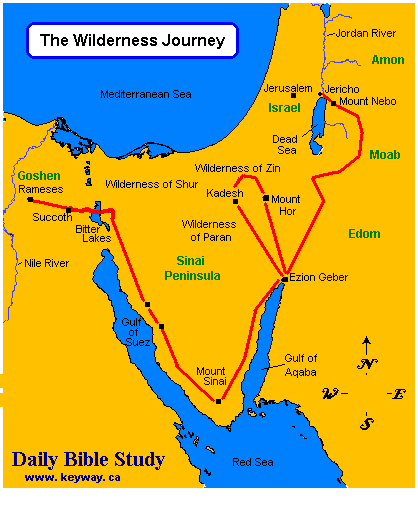|
“The whole Israelite community set out from Kadesh and came to Mount Hor. At Mount Hor, near the border of Edom, the Lord said to Moses and Aaron, “Aaron will be gathered to his people. He will not enter the land I give the Israelites, because both of you rebelled against my command at the waters of Meribah.Get Aaron and his son Eleazar and take them up Mount Hor. Remove Aaron’s garments and put them on his son Eleazar, for Aaron will be gathered to his people; he will die there.” Moses did as the Lord commanded: They went up Mount Hor in the sight of the whole community.” (Numbers 20:22-27, NIV)
Mentioned only a few times, Mount Hor is famous for being the death place of Aaron the high priest, brother of Moses. Numbers 20 tells us that Aaron will not see the Promised Land but will die on the mountain the Israelites have reached. In Numbers 33, “At the Lord’s command Aaron the priest went up Mount Hor, where he died on the first day of the fifth month of the fortieth year after the Israelites came out of Egypt. Aaron was a hundred and twenty-three years old when he died on Mount Hor.” (Numbers 33:38-39) In the following chapter, the Israelites are told of their new home. God pointed out the borders of their land with Mount Hor being one of the visible dividing lines.“For your northern boundary, run a line from the Mediterranean Sea to Mount Hor and from Mount Hor to Lebo Hamath.” (Number 34:7-8) This, however, is a different Mount Hor! In the Bible, the first Mount Hor, the site of Aaron’s death, is “near the border of Edom”, however, its exact location today is the subject of great debate. According to the Romano-Jewish historian Titus Flavius Josephus (37-100AD), the twin-peaked mountain Jebel Nebi Harun, which means “Mountain of the Prophet Aaron” in Arabic, is the true location. At a height of 4780 feet, the mountain is situated in the Edomite Mountains in Petra, Jordan. Also known as Jabal Hārūn, a shrine has been built at the summit, which claims to cover the grave of Aaron. Although Aaron and Moses are important to the Jewish faith, Jordanian authorities have ruled that the Tomb of Aaron may only be used as a mosque; therefore, Jewish pilgrims are not welcome. As mentioned, the second Mount Hor is the defining boundary of the Land of Israel. Traditionally, this has been associated with the Nur mountain range in Turkey. Originally called the Amanus Range, Jewish writers in circa 60AD were the first to make this association. As a result, they also claimed this to be the boundary of the Land of Israel, or Greater Israel as it is sometimes called. Israel was once a much large area than it is today. The Nur Mountains translate into English as “Mountains of Holy Light”. The highest point is Bozdağ Dağı, which reaches a height of 7350 feet. The location of both of the mountains is constantly challenged. There is no way to determine the exact locations, however, in the case of Aaron’s Mountain, the Edomite range in Petra continues to be the most popular choice. The ancient city of Petra was lost for hundreds of years, only to be discovered during archaeological digs in the 19thcentury. Now a UNESCO World Heritage site, Petra contains the remains of Roman and Byzantine ruins, suggesting it has a long and varied history. Aaron was not the only Biblical figure to be buried at Mount Hor. Whilst his resting place lies at the top of the mountain, his sister Miriam rests somewhere nearby. According to the Bible, Miriam died not long before Aaron and was buried in a high place. Logically, the Israelites would not have travelled very far if Aaron’s death occurred shortly afterwards, therefore, it makes sense that scholars believe they are both buried in the same vicinity. Tradition states that Miriam is buried below the Ad Deir Monastery in Petra. Before the Israelites arrived at Mount Hor, the Edomites were already living in the area. Later, in the 5thcentury BC, a group of Arabian nomads arrived in Petra, possibly escaping from the Babylonian invasion. They made the land their home and benefited from the overland trade routes leading to the Red Sea. Later, the land was taken over by the Romans, however, as a predominantly Muslim city, its importance waned when the Roman Empire converted to Christianity. Eventually, the city was abandoned and buried. Today, Petra is one of the most popular tourist destinations in the Middle East and the most visited Biblical location in Jordan. The grounds are extensive and Mount Hor, or Jabal Hārūn, is a two-mile hike from the visitor’s centre. Whether or not this is the true location of Aaron’s resting place, it is treated as such by Jewish, Christian and Muslim people alike.
3 Comments
Ronoh Stanley
4/24/2022 01:55:16 am
very impressive ,rich and clear explanatory historical events of major priest prophets of Israel especially death of Aron and Moses. God bless you the Author of the Article
Reply
Sara Smith
1/16/2023 09:45:17 pm
Thankyou! Was such a pleasure and insight to read! The Lord bless you and yours richly in this season with great rest and shalom
Reply
Malama Fesilafai
3/10/2023 10:38:41 pm
Pleased with the well documented story . Of Priest Aaron n the Mountain Hor
Reply
Your comment will be posted after it is approved.
Leave a Reply. |
©Copyright
We are happy for you to use any material found here, however, please acknowledge the source: www.gantshillurc.co.uk AuthorRev'd Martin Wheadon Archives
June 2024
Categories
All
|

 RSS Feed
RSS Feed